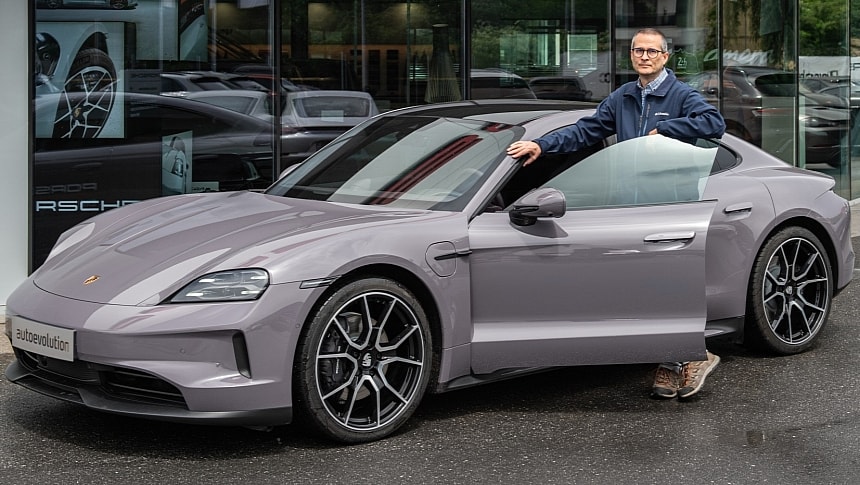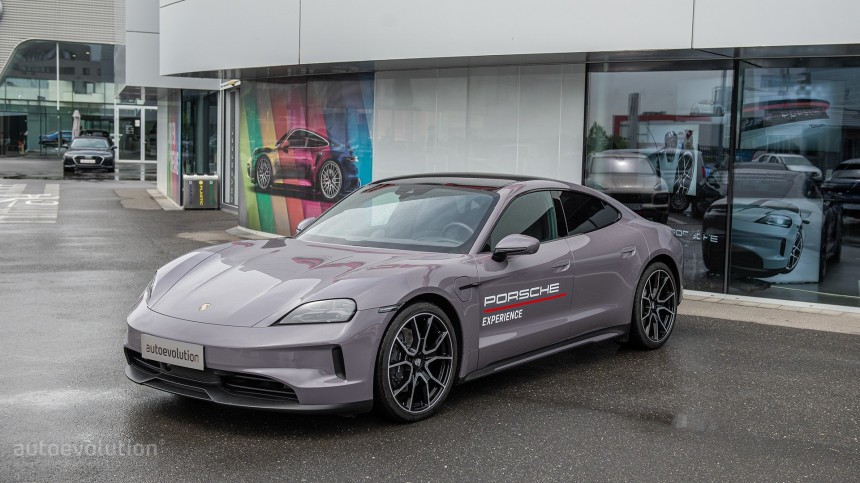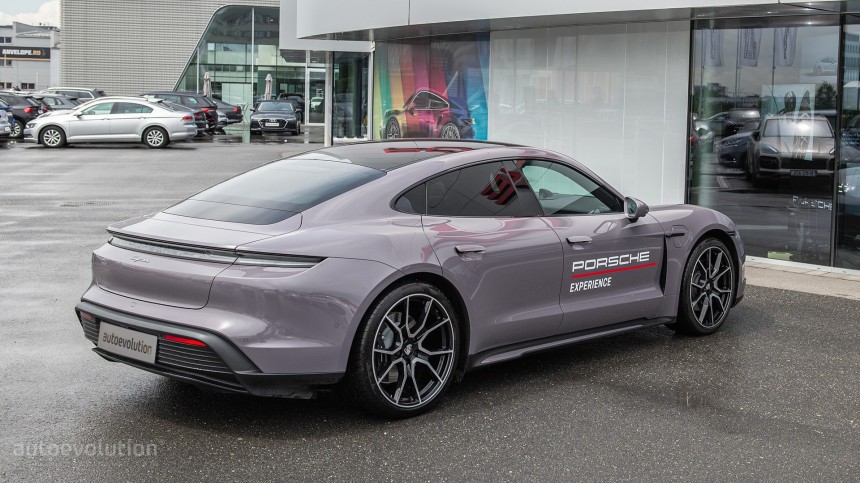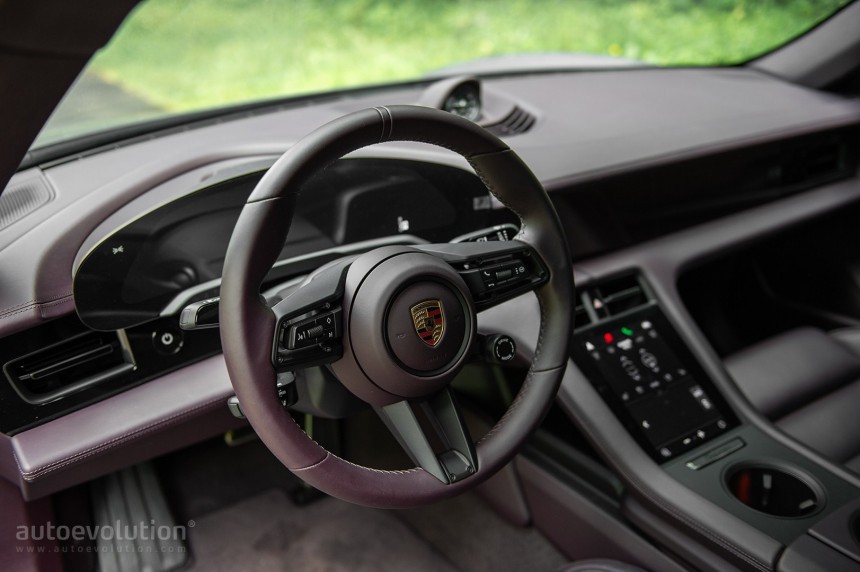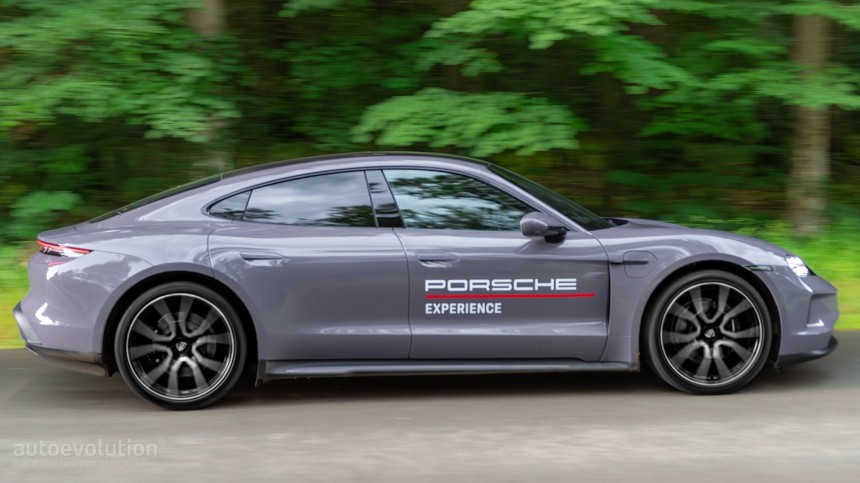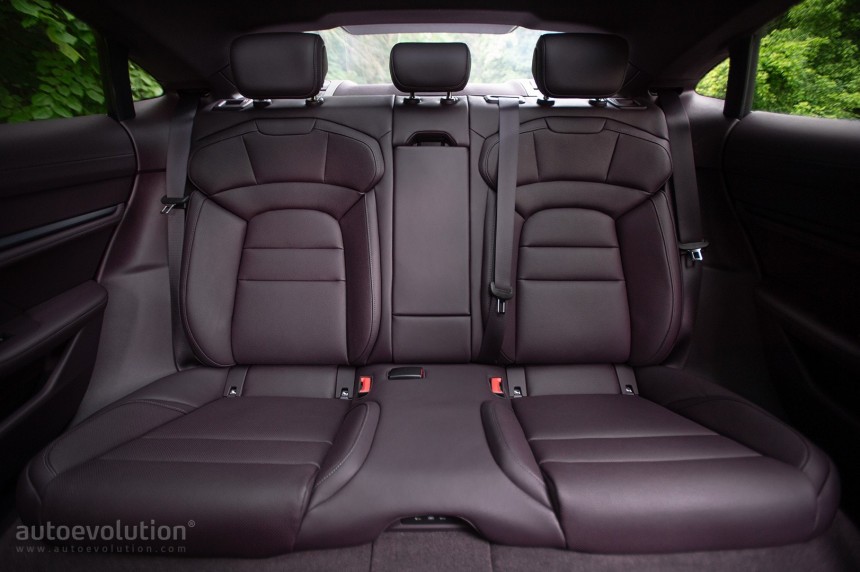Driven: 2025 Porsche Taycan – Thrifty Doesn't Mean Boring for This Entry-Level Luxury EV
Porsche refreshed the Taycan for the 2025 model year, and the updates transcend the optics, leaving deep marks on its performance. Even the entry-level Taycan with rear-wheel drive is a mean machine thanks to a healthy tech infusion and meaningful upgrades.
In the automotive world, Porsche stands apart not only as an aspirational brand but also as one of the most conservative. It would take a tectonic shift for the Zuffenhausen carmaker to make even the slightest design change to its vehicles. However, every now and then, folks at Porsche go completely nuts and come up with something so outrageous that it makes even its most ardent fans grind their teeth.
Probably the best example was the launch of the first company's SUV, the Cayenne, in 2002. This wild bet proved so successful that it emboldened the carmaker to go even wilder with a diesel variant in 2009. That must've been the year when Porsche executives thought, "What the heck!" and then the Panamera also got into this world. I must admit, it takes guts to take the 911 and turn it into an ugly limousine. However, people loved it and praised it as the only executive sedan that drives almost as nimble as the Elfer.
Although the Cayenne and Panamera show that Porsche loves risky bets, it didn't take any chances in the brand's first electric vehicle. Well, maybe a little, considering that powerful and noisy opposed-cylinder engines were the brand's signature. However, going electric is nowhere near as outrageous as a diesel Porsche, so fans gave it a pass. Coming soon after the Tesla Model S proved that electric vehicles can be both sexy and sporty, the Taycan soon became one of the best electric cars on the market.
Although it couldn't threaten the Tesla Model S in range and efficiency, the Taycan had an edge in charging performance thanks to an 800-volt electrical system. Porsche used this trick to shorten charging times between Nürburgring laps, and it proved so successful that it is now widely seen as the golden standard of electric vehicles. The Porsche Taycan wasn't cheap, but it could zip past combustion sportscars on a racetrack like a supercar, and Tesla noticed that.
Since then, Porsche and Tesla have regularly exchanged the title of the fastest electric vehicle on the Nürburgring. Currently, the Zuffenhausen carmaker is holding the trophy, thanks to the Taycan Turbo GT with Weissach package. I'm sure Tesla won't let this unpunished for long, considering how competitive it acted in the past.
While the top-of-the-range models act like a halo for a carmaker, most often, the base trim attracts the most customers. Earlier this year, Porsche offered the Taycan a well-deserved mid-cycle refresh, and the entry-level model was among the main beneficiaries. Unlike other mid-cycle updates in the automotive industry, there's little to talk about in the design department. However, important changes under the hood make the base Taycan a far better sportscar than before.
It's easy to dismiss the Taycan's design as a more thought-out derivative of the Panamera. They might share the design DNA, but subtle changes make all the difference in the world. Although it doesn't look like it, the Taycan is 29 mm/1.14 in wider than the Panamera and also sits lower. The altered proportions are enough to make the Taycan a car you love rather than one you can live with.
This being Porsche, you'd be hard-pressed to find distinctive design features compared to the pre-refresh model. The HD matrix LED headlights are flatter and now display Porsche's characteristic four-point light signature. You'll notice a three-dimensional, glass-look Porsche logo integrated into the rear light strip, and, this time, you can order an illuminated version featuring welcome/leaving animations.
Our tester came in Porsche's famous Provence color, a shade of lavender reportedly combining light purple and pink. Although it sounds awful, it looks quite good in real life. Porsche kept the spirit of an entry-level model intact with this configuration, but it didn't skimp on niceties. The 21-inch RS Spyder Design wheels are one of the reasons why this Taycan is such an eye-catcher.
Despite being an E-segment sedan, the Taycan doesn't offer the same sense of roominess as its cousin Panamera. This is especially true for the rear passengers. The more slanted roofline is the culprit, making the space a little tight for taller people. This also hinders visibility toward the rear, but thankfully, the Taycan features cameras and assistance systems to help the driver make sense of their surroundings.
The trunk offers a decent storage capacity if you're not the kind that packs everything and the kitchen sink when going on a road trip. The 407 liters (14.37 cu-ft) of storage space in the trunk is complemented by the 84-liter (3-cu-ft) frunk, enough for a suitcase. If you need more than that, you should consider the Sport Turismo and Cross Turismo variants.
Thanks to the uniformity across Porsche models, the dashboard looks familiar, and it feels even more at home for previous Taycan owners. However, Porsche has optimized the user interface, now offering new functions. Among the highlights is deeper integration with Apple CarPlay, allowing you to control vehicle functions from the CarPlay interface. For this to work, you need to install the My Porsche app on the phone, which will create an additional menu within CarPlay.
Porsche added more features to the Taycan's standard configuration with the refresh. These include the drive mode switch on the steering wheel, which features a special push-to-pass button on models equipped with the Sport Chrono package and the Performance Battery Plus. A new lever on the left side of the steering wheel allows more intuitive control of the driver assistance systems.
This is owed to a suspension setup worthy of a grand tourer. Porsche announced an upgraded drivetrain on the refreshed Taycan, with the adaptive air suspension replacing the previous steel suspension as standard. The new Porsche Active Ride suspension is optional, but our vehicle was not graced with it. Porsche promises it can absorb bumps almost completely, but the standard suspension works just as well.
Even when switching to the Sport setting, it doesn't feel as stiff as other sports models. This is even more extraordinary, considering the 21 wheels of this configuration. These are wrapped in Goodyear Eagle F1 tires with 265/35 ZR21 up front and 305/30 ZR21 on the rear axle. This should make them unforgiving, even with the shallower potholes, but it doesn't. Don't think that the Taycan rolls like a barge, though. It's still firm but well-behaved.
It seems pretty obvious that Porsche invested a lot into improving the Taycan's performance and range, and, boy, this sure is obvious on the entry-level Taycan trim. The new model develops 429 horsepower, up from 402 hp previously. This allows it to shave 0.6 seconds from the acceleration time, with 0-100 kph in 4.8 seconds (0-60 mph in 4.5 seconds) with launch control.
Make no mistake, the Taycan is a heavy car, at 2,090 kg (4,608 lbs.), although not as heavy as before. Despite having more standard equipment, the new model weighs 15 kg (33 lbs.) less. However, this is completely transparent while driving. Even in the Normal driving mode, saying that the Taycan accelerates is an understatement. It basically warps, that's how instantaneous the response you get from the accelerator pedal is.
This is true even when driving in Normal mode. Switching to Sport or Sport+ makes the accelerator more sensitive, squeezing that extra juice out of our Performance Plus battery pack. Porsche introduced an artificial sound generator to imitate a combustion engine sound, activated with the Sport and Sport+ modes. However, this is totally unnecessary, and it struck me as annoying before switching it off completely.
Floor the accelerator, and the pressure on your spine is relentless until it reaches the top speed of 230 kph (143 mph). There's only one perceptible kick when the two-speed gearbox switches up. This is unusual for an electric vehicle, but Porsche considered that a two-gear automatic transmission would improve performance. Tesla, for instance, relies on high-rpm electric motors that don't need additional gearing.
Braking is equally smooth, a marked improvement compared to the previous model. There's no perceptible difference between regenerative braking and the moment friction brakes take over. Although you cannot select different levels of energy recuperation, you can easily modulate the regen level using the brake pedal.
For this battery-motor combination, this means up to 678 km (421 miles) according to the European WLTP standard, an improvement of 175 km (109 miles). There's no EPA certification yet, although you should keep in mind that the European standard is way too optimistic in this regard. This performance is possible not only thanks to the bigger battery capacity but also efficiency improvements throughout the powertrain.
The new electric motor, combined with the modified pulse inverter and optimized software, means the 2025 Taycan is more efficient than ever. Porsche also fitted a next-generation heat pump and refined the recuperation strategy and thermal management to squeeze that extra mile of range. For instance, the maximum recovery during deceleration has increased from 290 kW to 400 kW.
Owners of the facelifted Taycan will certainly appreciate the faster charging times afforded by the 50 kW power capability increase. The Taycan can now charge at 320 kW on compatible 800-volt DC chargers. Porsche also optimized the charging curve, which means the car spends more time charging at high power levels. Instead of 37 minutes needed to charge from 10% to 80% at 15 degrees Celsius (59 degrees Fahrenheit), the refreshed Taycan only requires 18 minutes of charging.
Taycan charging performance and efficiency make living with an electric vehicle look like the new normal. However, the same is not true for its practical features. Porsche loves painting its sports cars as everyday vehicles, and the Taycan is more entitled than others, but that doesn't mean it's the perfect family vehicle. The low seating position and snug door apertures make entry and exit tricky for the less sporty person.
However, given how expensive the many extras in the Porsche configurator are, you better know precisely what kind of car personality you favor when ticking the boxes. Our test vehicle was remarkably modeled to offer a comfortable ride with very few unnecessary options. This makes it a perfect companion for those who appreciate calmness over brutal performance.
Probably the best example was the launch of the first company's SUV, the Cayenne, in 2002. This wild bet proved so successful that it emboldened the carmaker to go even wilder with a diesel variant in 2009. That must've been the year when Porsche executives thought, "What the heck!" and then the Panamera also got into this world. I must admit, it takes guts to take the 911 and turn it into an ugly limousine. However, people loved it and praised it as the only executive sedan that drives almost as nimble as the Elfer.
Although the Cayenne and Panamera show that Porsche loves risky bets, it didn't take any chances in the brand's first electric vehicle. Well, maybe a little, considering that powerful and noisy opposed-cylinder engines were the brand's signature. However, going electric is nowhere near as outrageous as a diesel Porsche, so fans gave it a pass. Coming soon after the Tesla Model S proved that electric vehicles can be both sexy and sporty, the Taycan soon became one of the best electric cars on the market.
Although it couldn't threaten the Tesla Model S in range and efficiency, the Taycan had an edge in charging performance thanks to an 800-volt electrical system. Porsche used this trick to shorten charging times between Nürburgring laps, and it proved so successful that it is now widely seen as the golden standard of electric vehicles. The Porsche Taycan wasn't cheap, but it could zip past combustion sportscars on a racetrack like a supercar, and Tesla noticed that.
While the top-of-the-range models act like a halo for a carmaker, most often, the base trim attracts the most customers. Earlier this year, Porsche offered the Taycan a well-deserved mid-cycle refresh, and the entry-level model was among the main beneficiaries. Unlike other mid-cycle updates in the automotive industry, there's little to talk about in the design department. However, important changes under the hood make the base Taycan a far better sportscar than before.
Design evaluation
As I've said, Porsche gave Taycan more thought than it did with the Cayenne and Panamera. The Mission E concept from 2015 showed the way, and thankfully, it wasn't a car-kenstein made of various Porsche body parts stitched together. The streamlined design makes the Taycan look like a proper coupe, albeit a four-door one. This makes it a tad more cramped than the Panamera on the inside, which is understandable considering that the wheelbase is slightly shorter, at 2,900 mm (114.2 in) instead of 2,950 mm (116.1 in).It's easy to dismiss the Taycan's design as a more thought-out derivative of the Panamera. They might share the design DNA, but subtle changes make all the difference in the world. Although it doesn't look like it, the Taycan is 29 mm/1.14 in wider than the Panamera and also sits lower. The altered proportions are enough to make the Taycan a car you love rather than one you can live with.
Our tester came in Porsche's famous Provence color, a shade of lavender reportedly combining light purple and pink. Although it sounds awful, it looks quite good in real life. Porsche kept the spirit of an entry-level model intact with this configuration, but it didn't skimp on niceties. The 21-inch RS Spyder Design wheels are one of the reasons why this Taycan is such an eye-catcher.
Interior assessment
Porsche gave this Taycan the full lavender treatment, with the color-matching Bramble leather interior. It's actually soothing to watch and even more satisfying to touch. It's fair to assume that people don't buy the Taycan RWD for its sporty characteristics, and Porsche acknowledged that masterfully. This is why I didn't miss the adaptive sports seats and found the configured Comfort seats a more appropriate option for this trim.Despite being an E-segment sedan, the Taycan doesn't offer the same sense of roominess as its cousin Panamera. This is especially true for the rear passengers. The more slanted roofline is the culprit, making the space a little tight for taller people. This also hinders visibility toward the rear, but thankfully, the Taycan features cameras and assistance systems to help the driver make sense of their surroundings.
The trunk offers a decent storage capacity if you're not the kind that packs everything and the kitchen sink when going on a road trip. The 407 liters (14.37 cu-ft) of storage space in the trunk is complemented by the 84-liter (3-cu-ft) frunk, enough for a suitcase. If you need more than that, you should consider the Sport Turismo and Cross Turismo variants.
Porsche added more features to the Taycan's standard configuration with the refresh. These include the drive mode switch on the steering wheel, which features a special push-to-pass button on models equipped with the Sport Chrono package and the Performance Battery Plus. A new lever on the left side of the steering wheel allows more intuitive control of the driver assistance systems.
Driving take
For many, an electric vehicle is not a real car because, with most models on the market, driving sensations take a back seat. There's very little differentiation among different EV models in terms of driving feel, but thankfully, this is not true for the Porsche Taycan. This is a driving machine through and through, and although it sounds lame, well, it drives like a Porsche. However, it doesn't negate its comfort-oriented nature and can take even moderate bumps with serenity.This is owed to a suspension setup worthy of a grand tourer. Porsche announced an upgraded drivetrain on the refreshed Taycan, with the adaptive air suspension replacing the previous steel suspension as standard. The new Porsche Active Ride suspension is optional, but our vehicle was not graced with it. Porsche promises it can absorb bumps almost completely, but the standard suspension works just as well.
Even when switching to the Sport setting, it doesn't feel as stiff as other sports models. This is even more extraordinary, considering the 21 wheels of this configuration. These are wrapped in Goodyear Eagle F1 tires with 265/35 ZR21 up front and 305/30 ZR21 on the rear axle. This should make them unforgiving, even with the shallower potholes, but it doesn't. Don't think that the Taycan rolls like a barge, though. It's still firm but well-behaved.
It seems pretty obvious that Porsche invested a lot into improving the Taycan's performance and range, and, boy, this sure is obvious on the entry-level Taycan trim. The new model develops 429 horsepower, up from 402 hp previously. This allows it to shave 0.6 seconds from the acceleration time, with 0-100 kph in 4.8 seconds (0-60 mph in 4.5 seconds) with launch control.
This is true even when driving in Normal mode. Switching to Sport or Sport+ makes the accelerator more sensitive, squeezing that extra juice out of our Performance Plus battery pack. Porsche introduced an artificial sound generator to imitate a combustion engine sound, activated with the Sport and Sport+ modes. However, this is totally unnecessary, and it struck me as annoying before switching it off completely.
Floor the accelerator, and the pressure on your spine is relentless until it reaches the top speed of 230 kph (143 mph). There's only one perceptible kick when the two-speed gearbox switches up. This is unusual for an electric vehicle, but Porsche considered that a two-gear automatic transmission would improve performance. Tesla, for instance, relies on high-rpm electric motors that don't need additional gearing.
Braking is equally smooth, a marked improvement compared to the previous model. There's no perceptible difference between regenerative braking and the moment friction brakes take over. Although you cannot select different levels of energy recuperation, you can easily modulate the regen level using the brake pedal.
Everyday living
One of the most important upgrades Porsche brought to the Taycan was the new battery packs featuring improved cell chemistry. Our Performance Battery Plus pack has a nominal capacity of 105 kWh, of which 97 kWh are available for use. This compares favorably to the 93.4/83.7 kWh nominal/usable capacity of the previous model, allowing the Taycan to travel 35% more on a charge.For this battery-motor combination, this means up to 678 km (421 miles) according to the European WLTP standard, an improvement of 175 km (109 miles). There's no EPA certification yet, although you should keep in mind that the European standard is way too optimistic in this regard. This performance is possible not only thanks to the bigger battery capacity but also efficiency improvements throughout the powertrain.
Owners of the facelifted Taycan will certainly appreciate the faster charging times afforded by the 50 kW power capability increase. The Taycan can now charge at 320 kW on compatible 800-volt DC chargers. Porsche also optimized the charging curve, which means the car spends more time charging at high power levels. Instead of 37 minutes needed to charge from 10% to 80% at 15 degrees Celsius (59 degrees Fahrenheit), the refreshed Taycan only requires 18 minutes of charging.
Taycan charging performance and efficiency make living with an electric vehicle look like the new normal. However, the same is not true for its practical features. Porsche loves painting its sports cars as everyday vehicles, and the Taycan is more entitled than others, but that doesn't mean it's the perfect family vehicle. The low seating position and snug door apertures make entry and exit tricky for the less sporty person.
Test drive roundup
Although it's no longer the revolutionary EV it was in 2019 when it launched, the Porsche Taycan has grown more refined and is now a much better car overall. The technology upgrades will keep the revamped model relevant in the coming years, and it still has an edge in charging performance. As the entry-level trim, the Taycan with Performance Battery Plus demonstrates impressive maturity and a great balance between comfort and sportiness.However, given how expensive the many extras in the Porsche configurator are, you better know precisely what kind of car personality you favor when ticking the boxes. Our test vehicle was remarkably modeled to offer a comfortable ride with very few unnecessary options. This makes it a perfect companion for those who appreciate calmness over brutal performance.
Pros
- Sophisticated ride
- Driving dynamics
- Balanced steering and braking
- Improved range
- Fast charging performance
Cons
- Ingress and egress a bit tight
- Not too much space in the back
- Unnecessary artificial engine sound
porsche taycan test drive Driven porsche taycan performance battery plus EV Porsche 2025 Porsche Taycan
About the author: Cristian Agatie

After his childhood dream of becoming a "tractor operator" didn't pan out, Cristian turned to journalism, first in print and later moving to online media. His top interests are electric vehicles and new energy solutions.
Full profile
